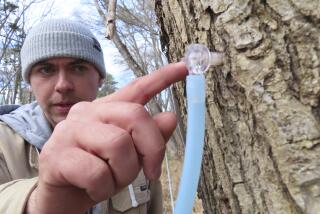Close to the Big Cities, but in Another World
- Share via
HOG WALLOW, N.J. — Emil Brown, 68, is one of a few hundred rugged individuals known as Pineys. Like their ancestors, they live in the Pine Barrens, New Jersey’s heartland, 1,000 square miles of pine forests, swamps and marshland.
It is another world--far from the fast lanes of north New Jersey, the urban crunch of Hoboken, Weehawken, Hackensack, Elizabeth, Jersey City and Newark.
“You can’t get any more rural than the way we are here,” said Adrienne McCauley, a transplanted New Yorker and principal of the wood-frame 1919 Green Bank School.
“We’re unsophisticated. If you are a Piney you can be yourself,” added Barbara Ford, 51, who prepares lunch everyday for the school’s 75 kindergarten through eighth-grade students. She is a ninth-generation Piney.
Brown is typical of the old-time Pineys, few of whom survive today. Like his ancestors, Brown lives in a primitive shack without electricity, telephone or indoor plumbing.
Modern Times
Most Pineys have caught up to modern times. Electricity came to the Pine Barrens in the ‘50s and ‘60s.
But Brown lives on a cranberry bog at the end of a one-lane dirt road in the woods near the village of Hog Wallow. He eats bellywax (molasses candy) and sea ketched (fish) and isn’t a skyscraper (one who has a high opinion of himself).
“I scoop (harvest) cranberries for me livin’, gun (hunt), trap some and cut wood,” Brown said, sitting on the hood of his 1959 Studebaker. Pineys, who have Elizabethan speech patterns, say me instead of my.
His home is a shambles, half of it gutted from a fire several years ago. “The old place is still fine for me own self,” Brown said. “You’re really in the Barrens when you’re in here at me place. Right smack in the middle. You can’t get further back, unless you get lost.”
New Jersey’s Pine Barrens is the last great wilderness between New England and Virginia on the Atlantic coast.
“When I was a small girl, Pineys never went beyond eighth grade. We were looked down upon as backwoodsy. But nowadays most of the young people graduate from high school,” said Blanche Ford Waters, 70, whose family has lived in Green Bank, population 100, since the 1700s.
“Pineys are down-to-earth people living in the woods. We’ve come a long ways. I raised all me six kids without electricity in this century-old house.”
Blanche and her husband, Bill Waters, 78, were drawbridge tenders at the Green Bank Bridge over the Mullica River until the bridge was electrified five years ago. Before that, the bridge was cranked open and shut by hand with an eight-foot-long, four-foot-high iron key.
“You cross the Green Bank Bridge and you go back 50 years in time,” one Green Bank schoolteacher said. “People here have their own way of thinking, their own way of life.”
Tough Times
Many Pineys never leave the immediate vicinity of their homes. Older Pineys tell of tough times during the Great Depression when they lived off the land.
“Pineys ate most any wild animal they could get their hands on, muskrat, raccoon, even skunk,” Bill Waters said. “They’d see a robin perch on a limb and blaze away with a gun. Every house would have a pork barrel and a sauerkraut barrel. What grew in the garden kept you over winter. Potato stew is still our favorite meal.”
To this day, “scoopin’ ” wild cranberries and cultivated blueberries provides most of the jobs. Some Pineys work on the narrow country roads crisscrossing their wilderness; others work for the state forest and parks in the Barrens. Some build boats. Others work in factories on the periphery of the Pine Barrens.
New Jersey’s great wilderness was named the Pine Barrens because of its poor soil. Early settlers in the late 1600s and early 1700s tried farming a variety of different crops but failed in every attempt.
Berry Industry
Only wild cranberries, huckleberries and blueberries thrived here, the birthplace of America’s cranberry and blueberry industries.
During the late 18th and early 19th centuries, the Pine Barrens was the site of a great iron ore industry and the woods were full of foundries where bog ore was mined.
One of the greatest mines was at Batsto, where a town was launched in 1766 and lasted until 1848. Historic Batsto Village--with its shingled miners’ homes, iron master’s mansion and spectacular castle--is now part of Whorton State Park and Whorton State Forest, 102,917 acres of uninhabited swamps and woodland.
In the forest are foundations of several old mining towns, places like Martha, Washington, Ongs Hat, Boar Stag, Bard’s Neck, Friendship and Belly Bridge.
Chatsworth, population 300, is the capital of the Pine Barrens. Other Piney villages include Jenkins Neck, Waiting River, Nesco, Bulltown, Lower Bank, Tabernacle and Apple Pie Hill.
The Pineys, seemingly so remote, are only 50 miles from downtown Philadelphia, only 125 miles south of Manhattan.
More to Read
Sign up for Essential California
The most important California stories and recommendations in your inbox every morning.
You may occasionally receive promotional content from the Los Angeles Times.











